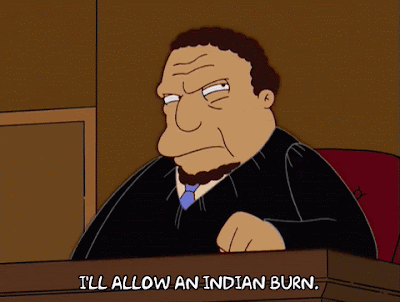________________
From Dianne M in Holland, a long time friend, in respect of 1920’s fashions and 1920’s women:
Hi Otto
Love the fashion of that time.
We as sisters would go through Mum`s photo albums , she was born in 1912 with the same styles.
Beautifully cut and designed, so nice.
Keep up your good work ,really enjoy the subjects and items you come up with.
Take care
Dianne
Thanks, Di.
________________
From Nadia H, in response to the following classic art meme:
Hey Otto!
Thought it was "Chinese Burn" and not "Indian Burn". (That's what we called it during the 60's and 70's).Now there's something to follow-up.
Cheers,
Nadia
You’re right, Nadia, I also remember them being called Chinese Burns. For those not in the know, a CB is the act of grabbing another person’s forearm with both hands, then twisting the hands in opposite directions. The action produces a painful friction burn on the skin.
Apparently they’re called Indian Burns in the US and Chinese Burns in the UK and Commonwealth countries such as Oz. I haven’t been able to find out why they are called those names, although I have read that in the US the names Icicle, Japanese Burn and Indian Sunburn are also used. Alternatives to Chinese Burns are Chinese Torture and Chinese Twist, but I have not heard those terms ever used. Maybe it is a regional thing.
The following is from someone posting on WordWizard:
Cassell’s Dictionary of Slang tells us that the expression derives from the stereotyped ‘fiendish cruelties’ of the ‘Red’ Indians and he notes that in the U.K.[also Canada, and Australia] – obviously in a magnanimous effort to be an equal opportunity discriminator against our friends in Asia – the same device is called CHINESE BURN.
Cassell’s claims that the expressions goes back to the 1930s. However, the Oxford English Dictionary’ss earliest citations date from the 1950s. I can attest to the fact that Indian burn goes back to at least the 1940s.
http://www.wordwizard.com/phpbb3/viewtopic.php?t=6838
So there you go, Nadia. Thanks.
________________
From Steve M, in response to the interesting photographs, in particular the following photograph of the unofficial, spontaneous WW1 Christmas truce (1914):
Good morning Otto,
What a terrific Bytes today! I enjoyed the photographs very much, especially the war related ones, as both World Wars are as you know, of particular interest to me.
A comment about the WW1 ‘Christmas Truce’ picture: There is a marvelous film called Joyeux Noel made by great French film maker, Christian Carion, staring the beautiful Diane Kruger and the well known German actor, Benno Furmann. The film covers the event mentioned in your photograph, though it extends the concept of the truce over a period of days. Despite the fact that the events are distorted somewhat to make the story fit, it is nonetheless a wonderful piece of work, and well worth watching. I would suggest the purchase of the DVD because it is accompanied by a separate disc, with interviews with the actors and the usual behind the scenes stuff, but it also includes an interview with one of the soldiers who was actually there, at the truce!
A wonderful film, that although it never received the accolades many believe it deserved, it was nominated for a BAFTA, Golden Globe and an Academy Award.
Byter, Nibbler and chewer of facts and interesting information,
Steve m
Thank you, Steve.
Noted film critic Roger Ebert has this to say about the film:
"Joyeux Noël has its share of bloodshed, especially in a deadly early charge, but the movie is about a respite from carnage, and it lacks the brutal details of films like Paths of Glory ...Its sentimentality is muted by the thought that this moment of peace actually did take place, among men who were punished for it, and who mostly died soon enough afterward. But on one Christmas, they were able to express what has been called, perhaps too optimistically, the brotherhood of man."
Funnily enough, the film was originally rated R in the USA. However, after Ebert criticised the rating, the MPAA officially changed the rating to PG-13
________________
Also in respect of the same Bytes post, Sue P sent me an email about the German soldier letting a child through barbed wire:
Sue writes:
Hi Otto
I’d love to know more about the Berlin soldier helping to reunite the child. You mention he was expelled from his unit - do you know what happened next? How did his life progress?
(I have previously posted items on the Berlin Wall, they can be read by clicking on the following links:
Unfortunately, to this day the identity of the soldier in the above photograph (and, like Tank Man at Tiananmen Square, his fate) remains unknown. Perhaps his punishment was minor, it was the first day of the Wall going up. I would like to think so.
As regards the little boy, according to Checkpoint Charlie Museum in Berlin, one of the boy’s parents, his father, was with the boy in West Germany visiting relatives while the rest of the boy’s family was at home in the East. The prohibition against crossing sectors occurred overnight, separating this family. The father believed that the boy should grow up with his mother, so he had the boy walk to the fence where this soldier lifted him across.
Take a moment to look at the photograph: the youth of the soldier, his face showing fear, but assisting a child whose innocence and trust has him holding his hands out, a child knowing not why he is standing in front of barbed wire and wanting only to go home. A moment when kindness and perhaps love overcame politics and barbed wire. A Joyeaux Noel moment.









No comments:
Post a Comment
Note: Only a member of this blog may post a comment.